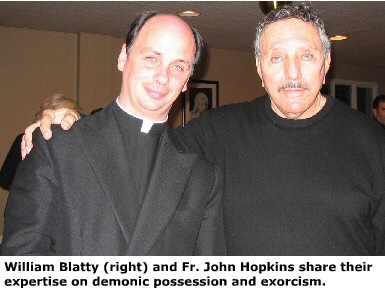|
Back to the December 2004 Newsletter Index Demonic Possession Rare But Real, Says Exorcist AuthorIn 1949 Fr. Eugene Gallagher, SJ, began telling his students at Georgetown University about the strange case of a 13-year-old boy in nearby Mt. Rainier who was apparently the victim of demonic possession. One of the students was a 21-year-old undergraduate named William Peter Blatty. “When I heard about it, I thought, if someone could research and document this, what a tremendous aid it would be to the faith,” said Blatty at an October 26 talk at Our Lady of Bethesda Retreat Center in Bethesda. In the ensuing years Blatty went on to become a writer, but his genre was comedy, not the supernatural. In addition to writing novels, he became one of Hollywood’s leading comedy screen writers, scoring with hits such as “John Goldfarb, Please Come Home,” “What Did You Do in the War, Daddy?” and the Inspector Clouseau farce, “A Shot in the Dark.” But by 1969 the market for comedy in Hollywood had dried up. Unemployed and idle, Blatty’s thoughts turned to the old tale of diabolical possession and exorcism. “I started researching demonic possession, but I couldn’t find a priest anywhere who did exorcisms,” Blatty recalled.
Father Bowdern was leery about Blatty’s desire to write about the case. He told the writer that his bishop had instructed him not to publicize it. In addition, said Blatty, “Bowdern felt such publicity would be hard on the boy who had been possessed. “But when I wrote to Bowdern, I said it could do wonders to buttress the faith of many.” The priest agreed, writing back, “My own thoughts were that much good would have come if the case had been publicized, making people aware of the Devil.” He added, “Good luck with your apostolate of the pen!” Blatty began putting in 16- to 18-hour days, researching and writing. He learned that the Mt. Rainier boy had dabbled in spiritualism with his aunt, using a Ouija board to communicate with spirits of the dead. When strange and upsetting things began happening to the boy after his aunt’s death, his parents turned to a Lutheran minister. The minister’s prayers failed to stop the increasingly frightening phenomena. He told the parents, “You have to see a Catholic priest. The Catholics know about things like this.” After a horrifying, failed attempt at exorcism by a local diocesan priest, the boy eventually underwent a rigorous and exhausting, but ultimately successful exorcism by Father Bowdern at the Alexian Brothers Hospital in St. Louis, Mo. While the Mt. Rainier case inspired Blatty, The Exorcist, published in 1971, was a complete work of fiction, an amalgam of many instances of possession and exorcism Blatty had uncovered in his research. To further distance the story from the Mt. Rainier boy and protect his identity, Blatty made the possessed child a girl. After The Exorcist came out, it languished in the doldrums, despite a multi-city publicity tour, until Blatty appeared on the Dick Cavett show. Cavett didn’t believe in demons or exorcists, and Blatty was scheduled dead-last on the slate of guests. But the two guests before him were “juiced” and “got the hook,” he said. “I ended up doing a 40-minute monologue. The following week my book was No. 4 on the best seller list.” The book, which sold 13 million copies in the U.S. alone, was followed in 1973 by the movie of the same name, which broke box-office records. Blatty joked about arguing with the director, William Friedkin, over the scene in which the possessed girl’s head appears to revolve completely around on her neck. “I told him, ‘Supernatural is not a synonym for impossible; nowhere in the recorded annals of demonic possession will you find a case where the head spins around 360 degrees!’” As moviegoers know, Blatty lost the argument. Blatty said that the knowledge he gained about demonic possession “was like a life raft to a man floating out there. I had faith, but it was weak. It shored up my faith.” Apparently it did so for others too. After the book was published, the priests at Loyola University in Los Angeles told Blatty they had never seen such a run on the confessional. “Do I believe in possession?” he reflected. “Yes, I do. Christ believed in it. Jesus referred to demons as unclean spirits. “I think what made the book work was my absolute certitude that it [demonic possession] was true.” Although demonic possession is more commonplace in Third World countries, it is extremely rare in our country, said Blatty: besides the Mt. Rainier case, he could only find two other cases in which the Church authorized exorcism in the U.S. The Church itself is very skeptical about reported cases of possession, he said; a Church decree in 1583 warned would-be exorcists about the danger of mistaking mental illness for diabolical possession. Still, Blatty warned, the occult should not be viewed lightly: “Don’t fool around with spiritism and Ouija boards; you can make yourself vulnerable.” He added that there has always been a connection between possession and mental illness, which “shatters the mind and makes it susceptible. Drugs is another way of bringing down the shield.” |

 Finally,
he contacted his old professor, Father Gallagher, who put him
in touch with Fr. William Bowdern, SJ, the Jesuit priest who
had performed the exorcism on the Mt. Rainier boy two decades
earlier.
Finally,
he contacted his old professor, Father Gallagher, who put him
in touch with Fr. William Bowdern, SJ, the Jesuit priest who
had performed the exorcism on the Mt. Rainier boy two decades
earlier.